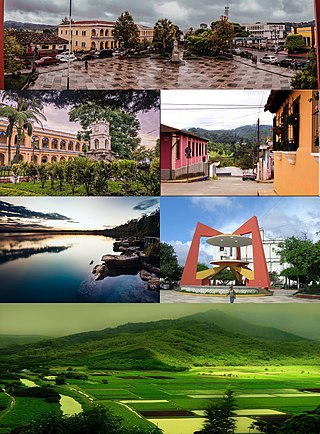
Cobán, fully Santo Domingo de Cobán, is the capital of the department of Alta Verapaz in central Guatemala. It also serves as the administrative center for the surrounding Cobán municipality. It is located 219 km from Guatemala City.

Livingston is a town, with a population of 17,923, in Izabal Department, eastern Guatemala, at the mouth of the Río Dulce at the Gulf of Honduras. The town serves as the municipal seat of the municipality of the same name. It was Guatemala's main port on the Caribbean Sea before the construction of nearby Puerto Barrios.
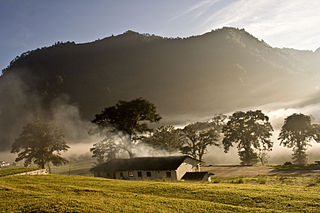
Quiché is a department of Guatemala. It is in the heartland of the Kʼicheʼ (Quiché) people, to the north-west of Guatemala City. The capital is Santa Cruz del Quiché. The word Kʼicheʼ comes from the language of the same name, which means "many trees".

The Maya are an ethnolinguistic group of indigenous peoples of Mesoamerica. The ancient Maya civilization was formed by members of this group, and today's Maya are generally descended from people who lived within that historical region. Today they inhabit southern Mexico, Guatemala, Belize, El Salvador, Nicaragua, and Honduras. "Maya" is a modern collective term for the peoples of the region; however, the term was not historically used by the indigenous populations themselves. There was no common sense of identity or political unity among the distinct populations, societies and ethnic groups because they each had their own particular traditions, cultures and historical identity.

The Riviera Maya is a tourism and resort district south of Cancun, Mexico. It straddles the coastal Federal Highway 307, along the Caribbean coastline of the state of Quintana Roo, located in the eastern portion of the Yucatán Peninsula. Originally the name applied narrowly, focusing on the area of coastline between the city of Playa del Carmen and Tulum. The designation has since expanded up and down the coast, now including the towns of Puerto Morelos, situated to the north of Playa del Carmen, as well as the town of Felipe Carrillo Puerto, situated 40 km (25 mi) to the south of Tulum. This larger region is what is currently being promoted as part of the Riviera Maya tourist corridor.

Guatemalans are people connected to the country of Guatemala. This connection may be residential, legal, historical or cultural. For most Guatemalans, several of these connections exist.
Senahú is a town and municipality of the Department of Alta Verapaz in the Republic of Guatemala.
Chisec is a town and municipality in the north of the Guatemalan department of Alta Verapaz that was founded in 1813. It is situated at 230 metres (755 ft) above sea level. The municipality covers a territory of 1244 km2. Approximately 95% of the municipality's inhabitants are Mayan, spread over the town of Chisec and approximately 140 communities. The Q'eqchi' language is widely spoken there alongside Spanish.
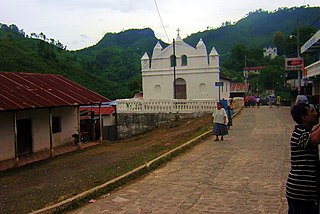
San Agustín Lanquín, often referred to simply as Lanquín, is a municipality in the Guatemalan department of Alta Verapaz. It is situated at 380 m above sea level. It has a population of about 16,500 people, many of Q'eqchi' Maya descent. It covers an area of 208 km².
The Qʼeqchiʼ language, also spelled Kekchi, Kʼekchiʼ, or Kekchí, is one of the Mayan languages from the Quichean branch, spoken within Qʼeqchiʼ communities in Mexico, Guatemala and Belize.

Trade in Maya civilization was a crucial factor in maintaining Maya cities.
Poqomchiʼ is a Mayan language spoken by the Poqomchiʼ Maya of Guatemala, and is very closely related to Poqomam. Its two main dialects, eastern and western, were spoken by 90,000 or so people in the year 2000, in Purulhá, Baja Verapaz, and in the following municipalities of Alta Verapaz: Santa Cruz Verapaz, San Cristóbal Verapaz, Tactic, Tamahú and Tucurú. It is also the predominant language in the municipality of Chicamán, which borders Alta Verapaz.

The Guatemalan Highlands is an upland region in southern Guatemala, lying between the Sierra Madre de Chiapas to the south and the Petén lowlands to the north.
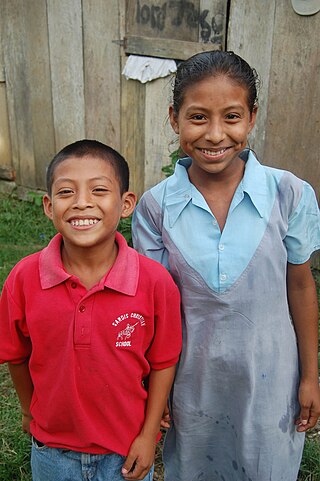
Qʼeqchiʼ are a Maya people of Guatemala and Belize. Their indigenous language is the Qʼeqchiʼ language.
Raxruhá is a town and municipality in the north of the Guatemalan department of Alta Verapaz. The municipality, which was formerly a part of Chisec, was founded in 2008.
Salinas de los Nueve Cerros is an archaeological site located in west-central Guatemala. It is the only Precolumbian salt works in the Maya lowlands and one of the longest-occupied sites in Guatemala.

Verapaz, formerly Tezulutlan, was a second order subdivision of the former Kingdom of Guatemala, itself a constituent part of New Spain.

The Manche Chʼol were a Maya people who constituted the former Manche Chʼol Territory, a Postclassic polity of the southern Maya Lowlands, within the extreme south of what is now Petén and the area around Lake Izabal in northern Guatemala, and southern Belize. The Manche Chʼol took the name Manche from the name of their main settlement. They were the last of a set of Ch'olan-speaking groups in the eastern Maya Lowlands to remain independent and ethnically distinct. It is likely that they were descended from the inhabitants of Classic period Maya cities in the southeastern Maya Lowlands, such as Nim Li Punit, Copán and Quiriguá.
A German Guatemalan is a citizen of Guatemala whose ancestors were German settlers who arrived in the 19th and 20th century. Guatemala had a massive immigration of Germans in the nineteenth century. The government of Justo Rufino Barrios provided them with farmlands for coffee in the departments of Quetzaltenango, Alta Verapaz and Baja Verapaz, and by the early 20th century Germans populated Guatemala City, Zacapa and Jutiapa. Guatemala currently has a strong community of Germans who make up the majority of European immigrants in the country, and it is also the most numerous German community in all Central American countries.
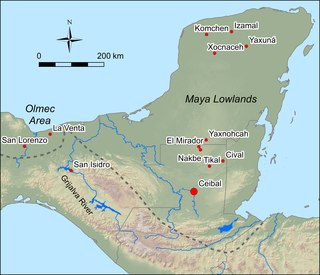
The Maya Lowlands are the largest cultural and geographic, first order subdivision of the Maya Region, located in eastern Mesoamerica.

















